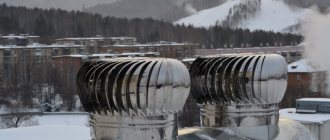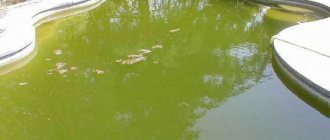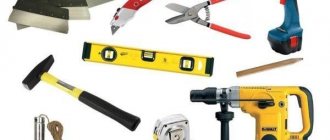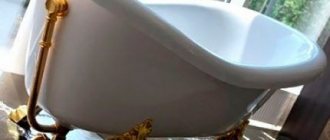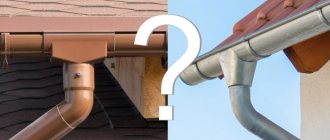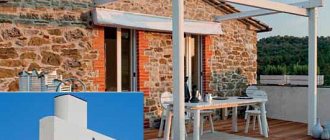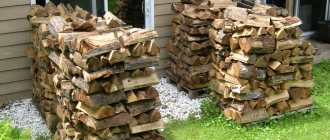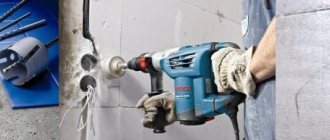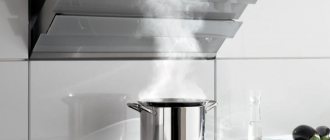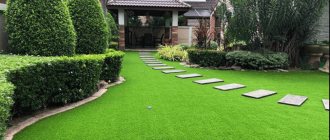For an experienced roofer, installing a modern drainage system is not particularly difficult, but an inexperienced person may not be aware of some of the nuances that lead to serious problems in the future. Of which, the most common are deformation, bending of the gutter, leakage and destruction of the facade from constant moisture.
Moreover, just one small installation error can cause all this. Therefore, we will now tell you in great detail how to fix the drain so that it serves faithfully for many years.
How to choose the right mount?
In total, to secure the drain you will need the following fasteners:
- Brackets on which you will attach the gutters. It will not be difficult for you to choose a suitable mount, based on the shape and dimensions of the purchased gutters.
- Clamps are special devices that allow you to attach drain pipes to the wall. This type of fastening is also selected depending on the type and size of the drain pipes. Also decide on the material for making the clamps: if it is plastic, then it has two attachment points, while metal ones have one, long hardware.
On sale you will find two types of hooks:
- The long ones are attached to the sheathing, to the rafter legs.
- Short ones - to the front board, according to the original plan or due to the fact that the roof is already installed.
The distance between the hooks should ideally be about 50 cm, maximum 60 cm. If you use long hook holders, it is better to screw them through the sheathing directly to the rafters, then the fastening of the drainage system itself will be more durable.
Upon completion of installation, both long and short hooks from above must be covered with a curtain rod.
Of course, according to all instructions, long hooks must be attached under the roofing directly to the sheathing. But there are often situations where it is not so easy to remove the old roofing covering, just as it is not possible to lift it up.
For example, it is old, so such hooks are often screwed even onto the hem of the cornice. Despite the illogicality of this method, in practice it often turns out to be rational and sometimes the only possible one.
Basically, according to the rules, metal hooks are used for metal drains, and plastic hooks for plastic ones. Today, copper hooks are rarely, but still used:
Construction of drainage systems
In recent years, galvanized steel has become less popular, and plastic structures have become popular.
Nowadays, plastic and metal are considered to be popular materials for the production of drainage systems. These materials have their positive and negative qualities. Not long ago, only galvanized steel was used for drainage systems.
This material was used not only for the manufacture of drainpipes and drainage systems, but also for the production of roofing coverings.
Advantages of plastic systems
In the production of drainage systems, the use of plastic is considered a plus. Because this material can be given any shape and painted in any color. For this reason, the use of plastic drainage systems allows not only to protect the building from excess moisture, but also to make it possible to implement some design ideas. A specialist in this field will be able to select a plastic drain in such a way that your home will be transformed.
The sale of ready-made kits is also considered good quality for plastic gutters. These kits are easy to assemble. But such ready-made sets are quite expensive, much more expensive than individual elements.
If you want to save money, then you should not buy ready-made kits for a drainage system, but it is better to purchase all the elements separately and make the system yourself. There will be no difficulties when installing such a system.
Disadvantages of using plastic elements
But it should be borne in mind that the negative quality of plastic elements is poor resistance to frost. For this reason, the design of the drain must be made so that the water in the drains does not stagnate or freeze.
In addition to plastic, drainage systems are also made from various metals. There are gutters made of copper and various alloys on sale, but such gutters are not cheap.
How to position the brackets correctly?
At this stage, you will have a completely expected question: how are gutters attached to the roof itself? Hooks for them are mounted to the front board, windshield, to the eaves overhang or directly to the rafters.
Fastenings are installed on rafter legs when there is no front board as such or it is important to leave it untouched for a certain aesthetic effect. But, if the roof is already ready, then the only rational option is to attach the fasteners to the front board:
Sometimes fasteners for the drainage system have to be installed directly to the roof sheathing. For this purpose, special elongated clamps are used, which are fixed at two points. The brackets are attached to the rafters (through the sheathing) only after being pre-bent.
Often home craftsmen try to save money and place the brackets too far from each other, although the distance between the fasteners should not exceed 60 meters. If this rule is not followed, over time the gutters will become deformed and gradually damaged under the pressure of the weight of water, ice and snow.
It is also important to guess the location of the brackets so that they are not too low or too high relative to the edge of the roof. If the hooks are located lower than necessary, rainwater from them will not flow well into the gutter, it will splash and streaks will appear on the facade.
Sometimes such an installation error even leads to breakage and breakage of the fastener itself. It is correct if the gutter protrudes slightly beyond the edge, at least half its width. If the drain is installed too high, then the mechanical pressure on it and its fastenings will be many times greater than normal, and the drainage system itself will have to bear the load of melting snow.
After completing the installation of the fastener, it is important to correctly install and align each hook:
Please also keep in mind that when installing metal tiles, an anti-condensation film with an allowance is also used:
Expert advice
Experts recommend installation according to the manufacturer’s instructions, without skimping on brackets, fasteners or the pipes themselves.
In addition, the drain does not need to be placed high, otherwise the water will end up on the wall of the house and destroy its facade. They also do not recommend using flimsy fasteners.
The standard one must withstand a load of up to 75 kg. But not only weight is important, but the supporting area. Due to the minimum number of installed holders, the pressure will be concentrated in one place and will not be distributed over the entire surface of the product. As a result, the gutter will break or become deformed.
How to fix the gutter yourself?
When installing any drainage system, it is extremely important to take into account the thermal movement of the gutter and its structural elements, which, depending on the material of manufacture, work differently in tension and contraction.
According to the rules, the only movable such element should be a hinged complaint, which is mounted without additional gluing - only on a latch. Moreover, modern manufacturers take care of this by making a special, so-called expansion mark inside the gutter, which helps to assemble in accordance with the air temperature at the time of installation.
Here's how to properly attach a gutter directly to an eaves overhang:
Our works
Gutter installation in Lianozovo
Installation of snow retention in the Provence CP
Installation of drainage on Volgogradsky Prospekt
How to attach modern plastic gutters?
In total, you will need the following tools to install a plastic drain: a cord, a hacksaw or grinder, a screwdriver or screwdriver, a hammer drill, a pencil, a tape measure, a ladder, a hook bender or a vice.
Let's look at an example of how to properly install a plastic drainage system. In total, you will only need to spend about a day on this activity. The main thing is to correctly calculate the slope of the gutter towards the funnel so that the water drains easily and the melted ice quickly falls down. According to building codes, it is advisable to make 1 cm of slope for each linear meter. Next follow these instructions:
- Step 1. So, we mark the hooks: place them on a flat surface close to each other.
- Step 2. Now on the hook where the gutter will be mounted, make notches as many centimeters as necessary to create a slope, and mark this place with a pencil.
- Step 3. Apply a ruler and draw a line from the first mark to the last. The line will not be horizontal, as you understand, and it is along this line that you will attach the brackets.
- Step 4. Next, if you have metal hooks, then you will need a special hook bender, but if not, then a small vice. They should be pinched along the line and bent towards themselves.
At this stage, we install all the hooks, checking the bend angle. Please note that the bend angle of all hooks should be the same, and only the bend location along the line should be different.
So, step by step:
- Step 1. Take the hook with the smallest bend and screw it to the cornice. You should end up with the highest side of the mount and the lowest side.
- Step 2. Make sure that the edge of the roof falls exactly in the middle of the hook. This is important so that the snow that slides down in winter does not damage the complaints and that rainwater falls exactly into the funnel.
- Step 3. Now stretch lacing or strong thread between the first and last hook, and attach all the remaining hooks clearly along this line. The distance between the hooks should be from 50 cm to 65 cm.
- Step 4. Now we take the gutters and install them. Please note that modern drainage systems have special strips along the edges of the drains that simply snap into place, and a clever rubber gasket protects them from leaks. It is usually black and hard to miss.
- Step 5: Now install the gutter cap. It should be placed first on the inside of the hook and pressed on its outside.
It is important that the mounted gutter is perpendicular to the ground:
We continue installing the drain:
- Step 1. The next step is to measure the distance from the funnel to the gutter connector, and keep in mind that during the installation process it will go into the funnel and connector up to 7 centimeters.
- Step 2. Install the funnel so that it is 20-30 cm from the edge of the roof.
- Step 3. Cut another piece of the complaint. It is most convenient to cut a plastic gutter with a regular hacksaw with a fine tooth, or with a grinder with a thin metal circle.
- Step 4. Now we take the funnel in our hands. Please note that it has special sides - these are limiters up to which you need to insert the gutter.
- Step 5. Install the funnel and gutters.
- Step 6. Now we move on to installing the knees. The elbows need to be installed on the drain hole of the funnel and turned towards the wall.
- Step 7. After this, take the second knee and measure the distance between them. The second elbow must be secured with a clamp.
- Step 8. The next step is to measure the distance to the drain elbow. It will be convenient to secure the clamp to the wall using self-tapping screws with a 30 mm press washer or a dowel if you have a brick house.
The following step-by-step photo illustration will help you consider the process in more detail:
Calculation of the required number of elements
For each building it is necessary to calculate the number of elements individually. Most modern houses are built according to unique designs - roof designs are very different. However, you can use a calculation template that will help you do the calculations yourself.
As an example, let’s calculate a drain for a roof with two slopes equal to twelve meters. You can set your own parameters to this value.
Calculation of gutters
Trays are sold by the meter - you need as much as the length of the cornices. It is often recommended to take into account thermal expansion compensation, but this is not necessary.
Calculation of corner gutters
Corner gutter elements are required if the drainage pipe runs along the facade of the building. The number of parts depends on the number of external and internal corners of the house. However, they must be taken into account, otherwise fastening the gutter will be difficult. With a cornice length of twelve meters, three elements are used to connect the structure.
Calculation of funnels, plugs and connectors
You need to buy two funnels and four plugs for one drainage tray. To calculate the number of brackets, divide the length of the cornice into segments of fifty cm. Don’t forget to retreat five cm on each side! The funnels are secured with holders.
The riser branches are constructed from two upper and lower bends. Pipe sections for connection will be required if the width of the cornice is more than 25 cm. Calculation and cutting are carried out when installing the storm drain on the roof, so it is impossible to calculate in advance. If the specified parameter is less, then it is permissible to simply join the knees.
In addition, pipes are used to remove moisture from the gutters. It is important to retreat from the surface of the earth up to forty centimeters. The risers are secured with two mandatory brackets. The first of them is mounted next to the lower elbow, and the second - with the drain riser. If necessary, do more, retreating one and a half meters.
For a house with a mansard roof, the drainage elements are calculated in a similar way. A similar principle also works with multi-tiered structures - you just need to carry out calculations separately for all slopes.
It is much more difficult to make calculations for a half-hip and hip roof. To create a drainage system, use at least 4 corners and 2 compensating connectors.
Even at the time of design and calculation of components, it is necessary to select the diameter of the cornice. It is important that the water does not accumulate, otherwise it will overflow. Precise selection of pipe diameter will avoid a bulky design. This is not only a matter of appearance, but also the cost of materials and installation.
Following technical recommendations, drainage from one square meter should take up about 1.5 cm2 of the cross-section of the drainage pipe. The figure was taken for a reason - this is an indicator for most Russian cities. You can calculate the required standard size yourself:
- Calculate the roof area treated with 1 funnel;
- Divide by one and a half - this will be the calculated value of the pipe cross-section;
- Round up to select the size of the gutters.
The area of slopes in typical buildings rarely reaches 70-80 m2. Many people don’t even do calculations, but use ready-made diagrams.
How to fix metal gutters?
Modern metal gutters do not always have mechanical latches, and therefore their parts must be joined by cold welding or using special glue:
Let's look at the technology of fastening metal drains in more detail. So, all the parts necessary to assemble such a system are produced in the factory with high precision, thanks to which you can assemble the elements into a single system yourself and without much effort:
- Step 1. The first thing you need to do is take exact dimensions and make a diagram of the fastening of the future drain to accurately calculate the number of pipes with fastening parts, gutters and brackets, gutter plugs, funnels and their connectors. And purchase all this from a quality manufacturer.
- Step 2. To set the correct slope of the gutter (5.0-10.0 mm is enough), secure the first and last brackets, and then stretch the cord between them. Step 3. Now let's move on to the installation itself. First, we install gutters with the obligatory maintenance of the required slope along the roof slope. Install the mounting brackets around the perimeter of the roof at a distance of 0.50 m.
- Step 4. It will be easier for you to connect several parts of a metal gutter of the same length on the ground using rivets and a special sealant. Close the ends of the gutters that will not drain water tightly with plugs.
- Step 5. Next, install drainpipes, which should be fixed in the required places on the walls. Connect the pipe sections themselves using clamps.
- Step 6. Check the vertical placement of the pipes with a plumb line. metal roof gutters.
- Step 7. Now connect the gutters with pipes and funnels.
- Step 8: Finally, install the bottom drain elbows in the desired direction.
Fashionable copper gutters are attached according to the same principle as conventional steel ones:
But the most difficult thing is installing a drain of complex shape:
Be sure to check the installed drain for reliability and leaks by simply pouring water into it from a garden hose:
Drainage installation
To install a plastic drainage system, you need to follow several steps.
First of all, you need to remember that the installation of drainage units must be done at a certain angle. This is done to prevent water from stagnating.
- The bracket fastening elements are installed during the construction of the structure.
- First, gutters are attached, then funnels for water are installed. Covers are attached to the ends of the gutters.
- After this, a vertical section of the drain is attached to the catchment funnel.
- A vertical section of pipe is attached to the wall using pre-installed brackets.
Fastening the drainpipe. Tips and tricks
Gutter gutters are attached to the walls using a bracket, which is screwed with self-tapping screws. Fastening the gutter to the front boards is used when using a drain made of polymer materials. In addition to self-tapping screws, metal anchors or nails can be used to attach the drainage system to the walls.
If you are going to install the drainage system during the construction of the roof, then the mounting brackets can be screwed to the rafter supports, from the bottom of the sheathing. When marking the fasteners for the drainage system, it is necessary to take into account the slope of the drainage gutters to the drainage funnels. The slope of the drain should be 5-10 degrees, this is necessary so that the water itself flows into the vertical drainpipes.
Polymer pipes, which are located vertically, are attached to the outer surface of the walls using strong fasteners. Metal brackets are used for fastening. The mounting bracket is fixed in the wall of the house with an anchor or self-tapping screw six centimeters deep.
When choosing brackets for fasteners, you need to take into account that the fasteners should be slightly larger than the diameter of the pipe.
Installation of gutters
Before starting the installation of horizontal drainage gutters, it is necessary to take all measurements and mark the mounting locations for the brackets. The brackets should be attached at a distance of no more than sixty centimeters. Then determine the angle of inclination of the horizontal gutter. To do this, you need to mark the position of the first and outer brackets; to do this, you need to stretch a cord or thread between them. The next step will be marking for fixing the remaining brackets.
Installation of the drainage gutter begins from the edges, but it is necessary to take into account that the vertical section of the pipe should be no further than fifteen centimeters from the nearest bracket!
Fastening the drain pipe
The pipe can be fastened either from the bottom or from the top. We will look at the second method.
First, you need to determine a place to fix the bracket, which will be located on top of the vertical section of the pipe. Be sure to take into account the width of the roof eaves and the size of the pipe elbow.
If the funnel for receiving water on the gutter is located far from the wall, then it is better to make a bend in the vertical section of the pipe.
Gutter installation
The vertical section of the drainpipe must be fixed approximately five centimeters from the outer wall of the house.
First, install the bracket from above, then use a plumb line to mark a vertical line and mark the places for fastening the brackets.
The fastenings on the vertical section of the pipe should be spaced at a distance of one meter.
When you have placed the brackets, then install the outlet; it should supply water from the gutter to the drainage funnel into a vertical section of pipe.
Then you mount the vertical section of the pipe and after fastening it, install an elbow at the bottom of the pipe to drain water into a container or onto the ground.
It is necessary to take into account that the junction of the outlet and the drain pipe must be attached to the wall with a separate bracket.
Good luck in your endeavors!
How to install a heating cable in a drain?
In order to protect the newly installed drain from being broken by ice during the first cold weather, today a cable heating system is being installed. It is an electrical cable that is stretched along the entire perimeter of the roof. It operates in temperatures from 0 to minus 15 degrees, and even in the presence of ice and water on the roof.
Such cables are equipped with a temperature main sensor. They are installed along the edges of the roof on the south side, and such sensors regulate the on/off switching of the cable system.
So, any gutter is always subjected to constant loads during its service. Especially if in your area it rains, snows and there are strong winds quite often. In addition, ultraviolet radiation and wind-blown debris have a destructive effect on the drain. And therefore, even a well-installed drainage system always needs to be looked after!
